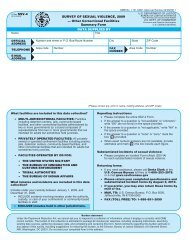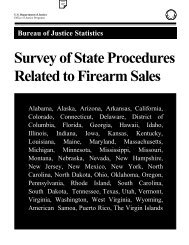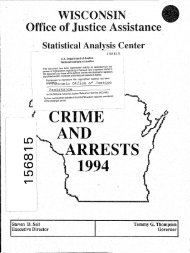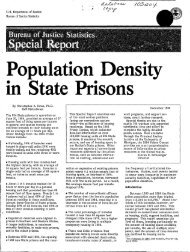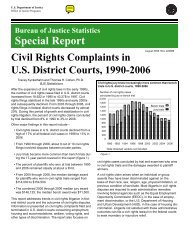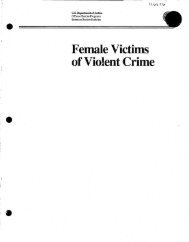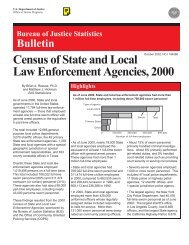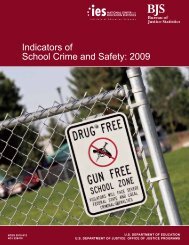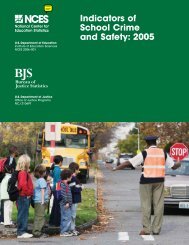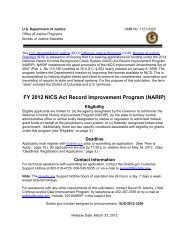<strong>Sourcebook</strong> <strong>of</strong> <strong>Criminal</strong> <strong>Justice</strong> <strong>Statistics</strong> 19H3Oregon--The 1980 yearend probation population has beenrevised. Yearend probation population includes unwarrantedabscanders but not those for whom warrants have been issued."Discharges" includes 1,5HO early terminations, 839 warrantedabsconders, and 187 odministrative closures. "Other exits"includes persons incarcerated while probation time remainsrunning.Pennsylvania--Yearend probation papulation does notinclude abscanders. "Discharges" includes 215 absconders.Rhode Island--Yearend probation population includesabsconders. "Exit totals" in Tables 6.3 and 6.5 are not the samedue to missing data.South Carolina--Yearend probation population includesabsconders.South Dakota--The data are for the year ending June 30,1981. Yearend probation population includes absconders.Tennessee--Yearend probation population does not incJuc',~abscanders. "Exit totals" in Tables 6.3 and 6.5 are not the somedue to missing data.Texas--Yearend probation population includes absconders."Discharges" includes 63,081 successful di scharges, 5,515unsuccessful discharges, and 1,536 administrative closures.Utah--Yearend probation population includes absconders."Other exits" includes terminated absconders. "Offense level"data are missing for 24 cases not included in Table 6.4.Verniont--Yearend probation population includesabscon(i.~rs.Virginia--The data are for the year ending June 30, 19HI.Yearend probation population does not include c:bsconders."Entries" includes 248 cases restored to supervision and 96 casesopened administratively. "Discharges" includes 1,855 expirations,1,735 court ordered discharges, and 130 cases closedadministratively. "Exit totals" in Tables 6.3 and 6.5 are not thesome due to missing data.Washington--The 19HO yearend probation population hasbeen revised to include unsupervised cases, warranted cases,"inactive letter" cases, cases supervised out-<strong>of</strong>-State andprobationers excused from reporting. Yearend probotionpopulation includes absconders.West Virginia--Yearend probation population does notinclude absconders.Wisconsin--The 19t1U probation population has been revised.The 198 I yearend probation population includes 2,506 absconders."Exit totals" in Tables 6.3 and 6.5 are not the same due tomissing dato. ''Offense level" data are missing for 9 cases notincluded in Table 6.4.Wyoming--Yearend probation population includes personswho have been on absconder status for less than 6 months. After6 months absconders for whom warranfs have been issued areremoved from the case load.Agencies providing dataMost <strong>of</strong> the central reporting agencies listed below reportdata representing all probationers within their State. Some,however, report data representing only a portion <strong>of</strong> the totalpopulation. In some instances (Alabama, Missouri, Nebraska,Tennessee, Texus, and Wyoming) the central reporting agency hada precise enoug:' handle on the total to make conversion fromtheir reported1umbers to the 100 percent estimate verystraightforward. ("'~exas, for example, reported on 97.69 percent<strong>of</strong> its total population; Nebraska's reported data cover allprobationers except those from 2 municipal courts, for whichyearer:d counts were readily available.) In the remaining partiallyreporting states (Arkansas, Georgia, Minnesota, Ohio, and SouthDakota) the National Probation Reports Program worked with thecentral reporting agencies, Gnd also used data from the U.S.Departmen t <strong>of</strong> Just ice, Law Enforcement AssistanceAdmini~tration, State and Local Probation and Parole Systems(W~shlngton, D.C.: U.S. Gc.vernment Printing Office, 197!l), toarrive at the most reasonable estimates possible.United States Courts {FederaJ}--Statistical Analysisand Reports Division, Administrative Office <strong>of</strong> the UnitedStates Courts.Alaboma--Board <strong>of</strong> Pardons and Paroles.Alaska--Division <strong>of</strong> Corrections, Department <strong>of</strong>Health and Social Services.Arizona--Administrative Director's Office, SupremeCourt <strong>of</strong> Arizona.Arkansas--Probation and Parole Services, Department<strong>of</strong> Corrections.California--<strong>Bureau</strong> <strong>of</strong> <strong>Criminal</strong> <strong>Statistics</strong> and SpecialServices, Department <strong>of</strong> <strong>Justice</strong>.Colorado--State Court Administrator's Office.Connecticut--Office <strong>of</strong> Adult Probation, ConnecticutJudicial Department.Delaware--Office <strong>of</strong> Probation-Parole, <strong>Bureau</strong> <strong>of</strong>Adult Correction.District <strong>of</strong> Columbia--Social Services Division, D.C.SUperior Court.Flodda--Planning, Research, alld <strong>Statistics</strong>;Deportment <strong>of</strong> Corrections.Georgia--Division <strong>of</strong> Probation, Department <strong>of</strong>Offender Rehabilitation.Hawaii--Planning and <strong>Statistics</strong> Division, Office <strong>of</strong> theAdministrative Director <strong>of</strong> the Courts.. Idaho--Department <strong>of</strong> Corrections, Division <strong>of</strong>Probation and Parole.IIlinois--Probation Division, Administrative Office <strong>of</strong>the Illinois Courts.Indiana--Division <strong>of</strong> State Court Administration,Indiana Supreme Court.lowa--Division <strong>of</strong> Adult Corrections, Department <strong>of</strong>Social Services.Kansas--Office <strong>of</strong> Judicial Administration.Kentucky--Research and Evaluation Unit, <strong>Bureau</strong> <strong>of</strong>Corrections.Louisiana--Office <strong>of</strong> Management and Finance,DepartmE.nt <strong>of</strong> Corrections.Maine--Division <strong>of</strong> Probation and Parole, Department<strong>of</strong> Mental Health and Corrections.Maryland--Division <strong>of</strong> Parole and Probation.Massachusetts--Office <strong>of</strong> the Commissioner <strong>of</strong>Probation.Michigan--Bureou <strong>of</strong> Field Services, Department <strong>of</strong>Corrections.Minnesota--Department <strong>of</strong> Corrections.Mississippi--Department <strong>of</strong> Corrections.Missouri--Board <strong>of</strong> Probation and Parole, Department<strong>of</strong> Social Services.Montana--Corrections Support <strong>Bureau</strong>, CorrectionsDivision, Deportment <strong>of</strong> Institutions.Nebraska--District Courts-State ProbationAdministration.Nevada--Department <strong>of</strong> Adult Parole and Probation.New Hampshire--Deportment <strong>of</strong> Probation.New Jersey--Administrative Office <strong>of</strong> the Courts.New Mexico--Field Services Bureou, CorrectionsDivision, <strong>Criminal</strong> <strong>Justice</strong> Deportment.New York--Divisior. <strong>of</strong> Probation.North Carolina--Division <strong>of</strong> Adult Probation andParole, Deportment <strong>of</strong> Corrections.North Dakota--Interstate Compact AdministrationOffice, Department <strong>of</strong> Parole and Probation.~hio--Probation Development Section, Adult ParQleAuthority.Oklahoma--Division <strong>of</strong> Probation and Porole,Department <strong>of</strong> Corrections.Oregon--Corrections Division, Department <strong>of</strong> HumanResources.Pennsylvania--Research and Statistical Division,Board <strong>of</strong> Probation and Parole.Rhode Island--Adult Probation and Parole,Department <strong>of</strong> Corrections.South Carolina--Probation, Parole, and Pardon Board.South Dakota--State Court Administrator's Office,lJI1ified Judicial System.Tennessee--Adult Probation, Deportment <strong>of</strong>Correction.Texas--Division <strong>of</strong> Information Services, Texas AdultProbation Commission (TI>PC).Utah--Adult Probation and Parole, Division <strong>of</strong>Corrections.Vermont--Research and Planning DIvision, Deportment<strong>of</strong> Corrections.Virginla--Research and Reportir,g Unit, Division <strong>of</strong>Program Development and Evaluation, Department <strong>of</strong>Corrections.Washington--Adult Corrections Division, Department<strong>of</strong> Social and Health Services.West Virginia--Administratlve Office, Supreme Court<strong>of</strong> Appeals, and Probation/Parole Services, Deportment <strong>of</strong>Corrections.Wi scons i n- -PI ann ing, Evaluation and StatisticalAnalysis Section; Division <strong>of</strong> Corrections; Department <strong>of</strong>Health and Social Services.Wyoming--Department <strong>of</strong> Probation and Parole.,tII.~Definitions <strong>of</strong> termsAPPENDIX 17Parole in the United States-Definitions <strong>of</strong> ter= and survey methodologyNJTE: This information was provided by the National Council on Crime and Delinquency, ResearchCenter West.The 1980 aggregate porole data were provided to the Uniform Parole Reports programvoluntarily by the parole authorities/corrections departments <strong>of</strong> the 50 States, the U.S. ParoleCommission, the District <strong>of</strong> Columbia, Puerto Rico, American Samoa, Guam, and the Virgin Islands.These data update the 1979 data published in National Council an Crime and Delinquency, UniformParole Reports, Parole in the United States: 1979 (San Francisco: National Council an Crimeand Delinquency, Research Center West, 1980). The 1981 parole data survey was used to collectdata from the 50 States, the U.S. Parole Commission, and the District <strong>of</strong> Columbia.Entries--Persons entering porole supervision from a correctionalfacility as a result <strong>of</strong> either parole, reparole, reinstatement, ormandatary supervised release.Mandatory supervised release--Persons entering parolesupervision from a correctional facility upon expiration <strong>of</strong> sentence notas a result <strong>of</strong> a paroling authority decision.Parole population--AII persons under the jurisdiction <strong>of</strong> aparoling authority. (Out-<strong>of</strong>-state parolees under courtesy supervisionare counted in the population <strong>of</strong> the paroling authority withjurisdiction.)Paroling authority--A board, commission, or authorityresponsible for parole supervision which mayor may not havediscretionary power to release <strong>of</strong>fenders from prison to the expiration<strong>of</strong> sentence, to revoke parole and return violators to prison, and toreinstate or grant other forms <strong>of</strong> reentry to porole supervision.Removals--Persons removed from parole: discharges, includingterminations, completion <strong>of</strong> term and early discharges; revocations andrecommitments to prison; and deaths.Agency explanatory notesU.S. Parole Commission (FederaJ)--The 1980 yearend parolepopulation has been revised. Yearend purole population includesabscanders. "Other entries" includes special parole, an additionalperiod <strong>of</strong> parole served following completion <strong>of</strong> regular parole ormandatory release by some drug <strong>of</strong>fenders as required under the DrugAbuse Prevention and Control Act <strong>of</strong> 1970. "Revocations" includesviolators who may not have been <strong>of</strong>ficially revoked but whose lastrecorded activity prior to the case being closed was a violation."Otner exits" includes terminations due to hospitaliZations,deportations, etc., and an adjustment residual.Alabama--The data are for fiscal year HHI. Yearend porolepopulation includes absconders. Abscanders are considered inactive,delinquent cases. "Discharges" is a Uniform Parole Report estimate tomake the yearend totals balance anel includes 29 persons who werepardoned.Alaska--Yearend parole population includes absconders. Thedata reported include only parolees released from prison through aparole board decision. Nat included are approximately 35 mandatoryreleasees under supervision <strong>of</strong> the Department <strong>of</strong> Corrections.Arizona--Yearend porale population does not include absconders."Entries" does nat ir,o::lude 276 work furloughees released during 1981under the coordinated supervision <strong>of</strong> the Community Treatment Centerand Adult Parole Services.Arkansas--Yearend parole population does not includeabsconders. "Discretionary entries" includes 56 persons paroled todetainers.California Deportment <strong>of</strong> Corrections--Yearend parolepopulation includes absconders. "Other entries" includes reactivatedcases.California Department <strong>of</strong> Youth Authority--Yearend parolepapulation i.ncludes absconders. On Dec. 31, 1981 there were 224absconders. "Other entries" inclUdes persons whose holding timeexpired, releasees from Department <strong>of</strong> Health institutions, etc. The"Entry" data in Tables 6.50 and 6.51 are not the same due to missingdata.Colorado--Yearend parole population does not includeQbscollders.Connecticut--Yearend porole population includes absconders.On Dec. 31, 19U I there were approximately 400 absconders."Discharges" includes 269 early discharges.De laware--Yearend parole population includes absconders."Discharges" includes dishonorable discnnrges.District <strong>of</strong> Columbia--Yearer." parole population includesunwarranted absconders but does not include absconders for whomwarrants have been Issued. The "Entry" and "Exit" data are not thesame in Tables 6.50 and 6.51 due to missing data.Florida--The 19BO yearend parole population has been revised.Yearend porole population does not include absconders. The datainclude mandatory parolees although the program is being eliminated.At the beginning <strong>of</strong> 1981 there were 921 mandatory conditiona Ireleasees but by the end <strong>of</strong> 198 I there were only 5.Georgia--The 19BO parole population has been revised. Yearendparole population does not include absconders. The data include out<strong>of</strong>-Statecases under supervision in Georgia, but do not include Georgiacases under supervision out-<strong>of</strong>-State. "Discretionary entries" includes689 youthful <strong>of</strong>fenders. "Exits" includes 542 youthful <strong>of</strong>fenders, 262 <strong>of</strong>whom were discharged and 280 <strong>of</strong> whom were revoked.Hawaii--Yearend porole papulation does not include absconders."Revocations" includes two persons revoked for technical violations.The "Exit" data are not the same in Tables 6.50 and 6.51 due tomissing data.Idaho--Yearend parole population includes absconders.IIlinois--Yearend parole population does nat include absconders.The "Exit" data are not the same in Tables 6.50 and 6.51 due tomissing data.Indiana--Yearend parole population does not include abscondersor inactive cases. Movement <strong>of</strong> the parole population includes transferswithin and between districts. "Other entries" includes reinstatementsand transfers. "Other exits" includes absconders, parolees placed onannual reporting status, parolees re
------------------------~included in the yearend parole population. "Other entries" includesparolees restored to active statu~. , The "Exit" data in Tables 6.50 and6.51 are neff the same due to missing data.Oklahoma--Yearend parole population includes abscondersOregon--The 1980 parole ~pulation has been revised Yearendparole papu!atio!' does not in.:lude absconders. "Discharges'; includes~arlY ter,ml,~~tlons, absconders, appeals, and administrative removals.~ther ex!ts Includes parolees who are incarcerated while their paroletime continues to run."D' Pe~nsYlvania~-Ye?rend parole population includes absconders.IscretlOnary ~ntrles" Includes 450 reparoles and 301 persons paroledfrom county prisons by county courts and supervised by the State.Rhode !sland--The, data are for fiscal year 1981. Yearendparole population does not Include absconders. "Other entries" includespers0!1 s whose supervision is resumed. The "Exit" aata in Tables 6.50and 6.5 I are not t~e same due to missing data."D' hSout~, ~arolana--Yearend parole popUlation includes absconders.ISC arges Includes 17 persons pardoned.South Dakota--The data are for the year ending June 30 1981The I d l980 yearend parole popUlation has been revised. "Other :ntries';inC U es suspended sentence cases (probotion).Tennessee-_ Yearend parole popUlation includes absconders.<strong>Sourcebook</strong> <strong>of</strong> <strong>Criminal</strong> <strong>Justice</strong> <strong>Statistics</strong> <strong>1983</strong>Texas--The ?ata are for the year ending Aug. 31 1981. Yearendparole population Includes 1,868 absconders. '" ' Utah--Yearend parole popUlation includes abscondersDI~ch?rges" includes 239 discretionary early discharges and 1!3expiratIOns <strong>of</strong> sentence.V7rm?n~--Yearend parole population includes obsconders." ' V'.rg,n,a--Yearend parole popUlation includes abscondersD,scretlon~ry entries" includes three conditional pardons. •, Wcishangton--The 1980 yearend parole population has been~e~lse " Yearend parole popUlation includes abscondersDlscre~,onary entries" includes 10 persons who were rantedGovernor s pardons and other conditional releaseesgb West Virginia--Yearend parole populatio~ does not includea sconders. "En~ries" and "Exits" are Uniform Parole Report estimates~nas:h~ 0~9~8e d~~~I.os <strong>of</strong> movement to yearend parole popUlation reportedWisconsin--The 1980 yearend parole popUlation has been revisediebrend parole papulation includes 215 absconders. The "Exit" data i~ales 6.50. and 6.5 I are not the same due to missing data." ' Wy?mmg--Yearend parole population includes abscondersDJ;'IZgtlonary entries" includes 69 persons by parole board decisio~an persons whose sentences were commuted by the Governor.Client Oriented Data Acquisition Process (CODAP), 1981 Annual Data-Survey' methodology and definitions <strong>of</strong> terms/tPPEf\D IX 18i'OTE:Survey methodology and limitations <strong>of</strong> the dataThis report contains information on clients admitted to anddischarged from federally funded drug abuse treatment programs In theUnited States and outlying areas. It is based on data collected fromthese units by the Notional Institute on Drug Abuse (NIDA) through theClient Oriented Data Acquisition Process (CODAP). CODN' is arequired reporting process for all drug abuse treatment andrehabilitation units receiving Federal funds for the provision <strong>of</strong> drugabuse treatment and rehabilitation services. CODAP admission anddischarge forms are completed for each client admitted to anddischarged from these clinics, regardless <strong>of</strong> source <strong>of</strong> funding supportfor any particular client. Thus, CODN' data reflect all clients treatedI at CODN' reparting units, not just those clients specifically supportedby Federal funds. CODN' Client Flow Summary forms are completedeach month by every clinic that reparts through COOftP, regardle,. <strong>of</strong>1: whether the clinic has any current admissions or discharges or anyactive clients in treatment.The data presented are based on a data file that has been editedI'I for internal consistency. The following information should beconsidered when using the reported data.Each admission reported on a CODN' form does not necessarilyj; represent a different client. To reduce multiple counting <strong>of</strong> someindividuals, records that represent transfer admissions between COON'I': clinics within a program are not included in the tables that containdata on clients admitted during the year.Tables that contain data on clients discharged during the yearI: are based on matched admission and discharge reparts. Thus, dischargeI reports for which there were no matching admission reports ore! excluded from these tables. - .To avoid the loss <strong>of</strong> useable information, reports with someincomplete or invalid information were retained and are excluded onlyIfrom those tabulations involving the specific items with Invalid1 responses. Thus, the number <strong>of</strong> clients on which related tables are~based varies somewhat from table to table.!In some instances, drug problem type and/or severity wasincorrectly reported on the CODN' forms. All tables in this report{ present data according to primary drug <strong>of</strong> abuse; thus, records onwhich the client's primary drug problem could not be identified areI excluded.Percentages shown in the tables have been rounded to thenearest tenth <strong>of</strong> a percent, i.e., fractional percentages <strong>of</strong> 0.05 orgreater have been rounded to the next higher tenth <strong>of</strong> a percent. Thist, rounding process results in some percent distributions adding to 99 orIU I percent; however, all "totals" reflect 100 percent.'I I; \ Definitions <strong>of</strong> termsIii \Age at admission--Derived by subtracting a client's year <strong>of</strong>: ~birth from year <strong>of</strong> admission to treatment.;1Age at first use--The chronological age at which a person firsti I! i used the drug now listed as his/her primary drug problem.jDrug users {clients)--Persons admitted to a clinic for theprevention <strong>of</strong> treatment <strong>of</strong> a drug problem; they are assigned to atreatment plan and receive the clinical and supportive servicesJ! identified in the regimen. Criteria for completing treatment arei Ii established at this time. When a clinic's Federal contract or grant,jstates that both prevention and treatment services are to be provided,the persons receiving prevention services are also considered clients.l IIIi ., The guidelines <strong>of</strong> the Federal funding agencies state that a client is'I ! considered active if he/she receives treatment services at least once!q i every 30 days. Only active clients are reported on CODAP. If the.J client has not received treatment or direct services for 30 days, he orilIshe must be discharged from the COON' reporting system. Partiali services are occasionally <strong>of</strong>fered to community groups, clients' families,iIand individuals; this activity is not repo,'led by CODN' clinic!; because1I r the people involved in receiving partial services ore not treated forIIdiagnosed drug problems.i'Drug types--Drugs are classified into 12 categorie~: heroin;other opiates--illegal methadone, opium, morphine, codeine, Demerol,il II Dilaudld, etc.; marihuana/hashish--includes THC, "hash oil," otherIJcannabis preparations; barblturates--phenobarbltal, Seconal, Nembutal,"etc.; omphetamines--Benzedrine, Dexedrine, methamphetamine, "speed,"Iijand related compounds such as Preludin, Ritalin, etc.; alcohol; cocaine;~ ! halluclnogens--LSD, mescaline, psilocybin, MCA, DMT, ffilJshrooms,I'peyote, etc.; PCP--"angel dust"; tranquilizers--Jibrlum, Valium,fi I!\'This information was excerpted from the U.S. Department <strong>of</strong> !-balth and Human Services,National Institute on Drug Abuse, Annual Data 1981, Data from the Client Oriented DataAcquisition Process (CODAP), Statistical Series E, No. 25 (Washington, D.C.: U.S. GovernmentPrinting Office, 1982), pp. I, 2, 369-374. Non-substantive editorial adaptations have been made.669Miltown, etc.; other sedatives or hypnotics--methaqualone, chloralhydrate, Placidyl, Doriden, etc.; other--Includes inhalants (glue, nitrousoxide, organic solvents, etc.), over-the-counter drugs (legally obtained,non-prescription medication), as well as any drug not falling into one<strong>of</strong> the above categories.Employment status--The following categories are used toindicate if the client is legally employed (including self-employment) atthe time <strong>of</strong> admission. To qualify as being employed, the client'searnings must be subject to income taxes. For example, stipends andwelfare payments are not taxable; therefore, the client receiving thesemonies would nat be considered employed. The categories ore:unemployed, not seeking work--has not sought employment in last 30days; unemployed, seeking work--has sought employment in last 30days (this includes registering with employment agencies, etc.);employed, part-time--working less than 35 hours a week; employed,full~time--working 35 or more hours a week (this category alsoincludes clients with concurrent full-time and part-time positions).Highest grade level completed--Number <strong>of</strong> years <strong>of</strong> educationthe client completed.Marital status--The following categories indicate the client'smarital status at time <strong>of</strong> admission: never married--this includesannulment; married--this includes commpn-Iaw marriage and thoseclients who consider themselves married; widowed; divorced; separated-this refers to married persons not living together by choice, whetheror not the separation is legal.Primary drug--The drug type that is the major problem in thatit has caused the mast dysfunction. Primary drug at admission is thedrug problem for which the client was admitted to treatment.Similarly, primary drug at dlsch::rge 15 the drug problem, if any,causing the most dysfunction at the time <strong>of</strong> dischorge Trur;; tregtment.Only or e primary problem may be reported at admission and one atdischarg\~.Race/ethnicity--Based 01'1 staff observation and client selfidentification,the following categories have been selected to conformwith the Federal Interagency Committee on Education Ad HocSubcommittee on Racial and Ethnic Definitions: White (not <strong>of</strong> Hispanicorigln)--a person having origins in any <strong>of</strong> the pe(1ple <strong>of</strong> Europe, NorthAfrica, or the Middle East; Black {not <strong>of</strong> Hispanic origin)--a personhaving origins in any <strong>of</strong> the people <strong>of</strong> sub-S(Jharan Africa; Hispanic-Mexican, Puerto Rican, Cuban, or other Hispanic; other--includesAmerican Indian (a person having origins in any <strong>of</strong> the original people<strong>of</strong> North America), Alaskan Notive (a person· such as Aleut or EskimoIndian who has origins In any <strong>of</strong> the original people <strong>of</strong> North America),and Asian or Pacific Islander (a person having origins In any <strong>of</strong> theoriginal people <strong>of</strong> the For East, Indian subcontinent, Southeast Asia, orthe Pacific Islands).Reason for discharge--The circumstances under which a clientleaves treatment. :,everal types <strong>of</strong> discharge are reported as follows:Completed treatment, no drug use--The client hassuccessfully completed the prescribed treatment regimen in theprogram and no further treatment services are prescribed withinthis program or ar:y other program; however, follow-up contactmay be recommended. The client is no longer using illegal drugsor abusing alcohol.Completed treatment, some drug use--The decision <strong>of</strong>the clinic staff is that the client has successfully completed theprescribed treatment regimen In the program, and no furthertreatment services are prescribed within this program or anyother program. The client meets all other criteria· for completion<strong>of</strong> treatment except concerning the use <strong>of</strong> drugs during the monthprior to discharge.Transferred/referred--The client is discharged from theclinic and, with no interruption in treatment, is transferred toanother clinic that is within the same program; or, the client isdischarged from the clinic and referred to another drug treatmentprogram or to a medical or psychiatric iostitution.Program decision to discharge client fornoncompliance with program rules--Treatmftnt is notcompleted; the client is discharged for violation <strong>of</strong> program rUles.Left before completing treatment--The client isdischarged because <strong>of</strong> his/her decision to leave the clinic beforecompletion <strong>of</strong> treatment, or his/her refusal to continue a furtherphase <strong>of</strong> treatment in this or any other program.Incarcerated--Treatment is not completed; the client isdischarged because <strong>of</strong> incarceration.Died--The client died before completing treatment;
- Page 1 and 2:
u.s. Department of JusticeBureau of
- Page 3 and 4:
________ n~'·••SOURCEBOOKOF CR
- Page 5 and 6:
Sourcebook of Criminal Justice Stat
- Page 7 and 8:
Figure B An overview of detelnclude
- Page 9 and 10:
--------- - --Svurcebook of Crimina
- Page 11 and 12:
- - .. "-- - ~------~ ------------C
- Page 13 and 14:
Figure3.12 Estimated rate (per 100,
- Page 15 and 16:
TableFig. 2.6 Respondents taking pr
- Page 17 and 18:
Sourcebook of Criminal Justice Stat
- Page 19 and 20:
---------- - -- ~------------------
- Page 21 and 22:
- ...... - ~r---~---------~--------
- Page 24 and 25:
------------- - ~------~-----~-----
- Page 26 and 27:
Sourcebook of Criminal Justice Stat
- Page 28 and 29:
--------- -' -- - -'-- ----~-------
- Page 30 and 31:
---- -- --~------~ ---rl.Sourcebook
- Page 32 and 33:
~~---------- ---~----------~-------
- Page 34 and 35:
-------------- - ---~---~--------~-
- Page 36 and 37:
~~~~~~~---- - -- -Sourcebook of Cri
- Page 38 and 39:
----.... ....--.-. ~"'-.~Sourcebook
- Page 40 and 41:
(Sourcebook of Criminal Justice Sta
- Page 42 and 43:
-----~---------------------.-'-----
- Page 44 and 45:
Table 1.13 Number and rateOct. 31,
- Page 46 and 47:
~-~- ~-...--~ -- ~ ---,~-------. -.
- Page 48 and 49:
-- ..... -,-.--..-... ~~----r; __ '
- Page 50 and 51:
---..0lIl, - -~,..--- -- - - ----~-
- Page 52 and 53:
-----------------------------------
- Page 54 and 55:
.~------~--------------------------
- Page 56 and 57:
"Sourcebook of Criminal Justice Sta
- Page 58 and 59:
------------ - -- -"\I'Sourcebook o
- Page 60 and 61:
Sourcebook of Criminal Justice Stat
- Page 62 and 63:
Sourcebook of Criminal Justice Stat
- Page 65 and 66:
---- ~------~--~- -..---Sourcebook
- Page 67 and 68:
Sourcebook of Criminal Justice Stat
- Page 69 and 70:
.~f'ISourcebook of Criminal Justice
- Page 71 and 72:
Characteristics of the Criminal Jus
- Page 73 and 74:
f'Sourcebook of Criminal Justice St
- Page 75 and 76:
--'~--~---------------_..."'.".,..,
- Page 77 and 78:
'Sourcebook of Criminal Justice Sta
- Page 79 and 80:
------ ~---~-----~-----~Sourcebook
- Page 81 and 82:
-----------~-~---~-------Sourcebook
- Page 83 and 84:
-----~---~~~. -'""".-=-./}Character
- Page 85 and 86:
--------------------Sourcebook of C
- Page 87 and 88:
-----------------------------------
- Page 89 and 90:
[!r-·ISourcebook of Criminal Justi
- Page 91 and 92:
- _. - -------~--...;--~"-"----- --
- Page 93 and 94:
.~. ---..ot--~.....--- -- ~------_.
- Page 95 and 96:
Sourcebook of Criminal Justice Stat
- Page 97 and 98:
--""'1,- ~,.--- --_'M~II!tlT'-~'r.
- Page 99 and 100:
- -~--~--~-~~-------~----------Tabl
- Page 101 and 102:
~~--~~--~-----~ ----Sourcebook of C
- Page 103 and 104:
~-~-------------------------_--____
- Page 105 and 106:
------------Sourcebook of Criminal
- Page 107 and 108:
Sourcebook of Criminal Justice Stat
- Page 109 and 110:
Characteristics of the Criminal Jus
- Page 111 and 112:
------- -- - -- -Sourcebook of Crim
- Page 113 and 114:
"Sourcebook of Criminal Justice Sta
- Page 115 and 116:
Sourcebook of Criminal Justice Stat
- Page 117 and 118:
------"'--~ ,'~- =--Sourcebook of C
- Page 119 and 120:
Sourcebook of Criminal Justice S;at
- Page 121 and 122:
,,iSourcebook of Criminal Justice S
- Page 123 and 124:
Source: George H. Gallup, The Gallu
- Page 125 and 126:
----~------~~--~----------~--------
- Page 127 and 128:
Sourcebook of Criminal Justice Stat
- Page 129 and 130:
--------------Sourcebook of Crimina
- Page 131 and 132:
--~-~~~~---------'---Public Attitud
- Page 133 and 134:
---------------------Sourcebook of
- Page 135 and 136:
-----------------------------------
- Page 137 and 138:
----------- --~-_.------~---t]Sourc
- Page 139 and 140:
Sourcebook of Criminal Justice Stat
- Page 141 and 142:
234Sourcebook of Criminal Justice S
- Page 143 and 144:
Sourcebook of Criminal Justice Stat
- Page 145 and 146:
~---.-.-.~~~ .. ~.Sourcebook of Cri
- Page 147 and 148:
,~--------~---------------~--------
- Page 149 and 150:
-~---------i': 1r\ jI~1 Public Atti
- Page 151 and 152:
--~---------------~----------Source
- Page 153 and 154:
~-~ - -'--~-------~----~~----------
- Page 155 and 156:
~-~- ~-----------------------------
- Page 157 and 158:
· -.Figure 2.14 Attitudes toward t
- Page 159 and 160:
Sourcebook of Criminal Justice Stat
- Page 161 and 162:
Sourcebook of Criminal Justice Stat
- Page 163 and 164:
--"'" - -~--..--- -Sourcebook of Cr
- Page 166 and 167:
.,.----------- - --" ,,jSourcebook
- Page 168 and 169:
~---~----~---" '--Sourcebook of Cri
- Page 170 and 171:
Sourcebook of Criminal Justice Stat
- Page 172 and 173:
....... ,-"'-~--... ~.Sourcebook of
- Page 174 and 175:
-- ..... --~.....-- -- -~ --'\,j--S
- Page 176 and 177:
"~Sourcebook of Criminal Justice St
- Page 178 and 179:
--~----- --~-----r\ I,I.-------. "
- Page 180 and 181:
---------------------,-------------
- Page 182 and 183:
Sourcebook of Criminal Justice Stat
- Page 184 and 185:
--------------------_.;e __ ... , .
- Page 186 and 187:
-----_.----------------------------
- Page 188 and 189:
--~--~-...---Sourcebook of Criminal
- Page 190 and 191:
----....--,-"..__._-..- ~ -- ~~ ...
- Page 192 and 193:
-- ..... -~-..---=4'CI)("")CI)9:::s
- Page 194 and 195:
-~-~ -----------------Sourcebook of
- Page 196 and 197:
Nature and Distribution of Known Of
- Page 198 and 199:
--------.-~ '-'=~~-------- -- -I1Na
- Page 200 and 201:
Nature and Distribution of Known Of
- Page 202 and 203:
---------~----------------~--------
- Page 204 and 205:
-------'''*'''_''' __ ,~=IW".(ISour
- Page 206 and 207:
;1INoture ond Distribution of /
- Page 208 and 209:
~~~-~----- ---- -~---~---~--~~-----
- Page 210 and 211:
Sourcebook of Criminol Justice Stat
- Page 212 and 213:
~ ---~ ---------- - ---Sout!:eboci<
- Page 214 and 215:
- ~--J."'~~~"_~ ..~F'"-_ ....Source
- Page 216 and 217:
Nature and Distribution of Known Of
- Page 218 and 219:
--------"Source bo 0 k of Crimi no
- Page 220 and 221:
Sourcebook of Criminol Justice Stat
- Page 222 and 223:
"---- ~ -------~~ -----------------
- Page 224 and 225:
.------~~- --~Sourcebook of Crimina
- Page 226 and 227:
396----------- -- ~Sourcebook of Cr
- Page 228 and 229:
Sourcebook of Criminal Justice Stat
- Page 230 and 231:
--Agure 3.24 Rate (per 100 officers
- Page 232 and 233:
407-~------- ----Sourcebook of Crim
- Page 234 and 235:
------------- -- ~Sourcebook of Cri
- Page 236 and 237:
Characteristics and Distribution of
- Page 238 and 239:
---.0lIl, - ~-.,---------- . ---Sou
- Page 240 and 241:
--~----~c,Sourcebook of Criminal Ju
- Page 242 and 243:
------------ - -- ----- --------~II
- Page 244 and 245:
- ----~--~\"r--. 'I[I)1Ir ri II.~\,
- Page 246 and 247:
.~--,..., - -~ --..--- --~ ----~---
- Page 248 and 249:
-------_ .. -Sourcebook of Criminal
- Page 250 and 251:
Sourcebook of Criminal Justice Stat
- Page 252 and 253:
----.------------------------------
- Page 254 and 255:
------------ - ~"Sourcebook of Crim
- Page 256 and 257:
Sourcebook of Criminal Justice Stat
- Page 258 and 259:
-------- --------~------------rSour
- Page 260 and 261:
-~--~......--- --------------------
- Page 262:
Sourcebook of Criminal Justice Stat
- Page 265 and 266:
---~--- ----------- ---------------
- Page 267 and 268:
~--~----------~--------------------
- Page 269 and 270:
----------- _. ---~--------~------.
- Page 271 and 272:
Sourcebook of Criminal Justice Stat
- Page 273 and 274:
------------------- ---------------
- Page 275 and 276:
--"~ ~- .... -~--,-----Sourcebook o
- Page 277 and 278:
~-~--~......--- --------~--~- - ~--
- Page 279 and 280:
."Sourcebook of Criminal Justice St
- Page 281 and 282:
Sourcebook of Criminal Justice Stat
- Page 283 and 284:
Judicial Processing of DefendantsFi
- Page 285 and 286:
Sourcebook of Criminal Justice Stat
- Page 287 and 288:
Sourcebook of Criminal Justice ;ita
- Page 289 and 290:
--- ..... - ~-..--~--------. - ---I
- Page 291 and 292:
- ~-----~----~ -~--Figure 5.9 Civil
- Page 293 and 294:
'rIlfI. '"• ""' .. t.':>\._ ;~~,
- Page 295 and 296:
."Sourcebook of Criminol Justice St
- Page 297 and 298:
---------- - -- -Sourcebook of Crim
- Page 299 and 300:
Figure 5.11 Obscenity complaints re
- Page 301 and 302:
- ----..--~Sourcebook of Criminal J
- Page 303 and 304:
Sourcebook of Criminal Justice Stat
- Page 305 and 306:
--~- ~,,------------ -- ~JUdicial P
- Page 307 and 308:
Sourcebook of Criminal Justice Stat
- Page 309 and 310:
"Sourcebook of Criminal Justice Sta
- Page 311 and 312:
Table 6.4 Level31, 1981Sourcebook o
- Page 313 and 314:
Sourcebook of Criminal Justice Stot
- Page 315 and 316:
------ --------------------~-------
- Page 317 and 318:
Sourcebook of Criminal Justice Stat
- Page 319 and 320:
'""' - .----~-- ---~---------------
- Page 321 and 322: ---.0lIl,- ~--,.--- - - - ---------
- Page 323 and 324: Sourcebook of Criminal Justice Stat
- Page 325 and 326: ---~~--- --- - --Sourcebook of Crim
- Page 327 and 328: Sourcebook of Criminal Justice Stat
- Page 329 and 330: -------- ---~-Sourcebook of Crimina
- Page 331 and 332: :Sourcebook of Criminal Justice Sta
- Page 333 and 334: Sourcebook of Criminal Justice Stat
- Page 335 and 336: -'•Sourcebook of Criminal Justice
- Page 337 and 338: ,-.-~------......-~-----n.~-".~" ..
- Page 339 and 340: SourcebG,.lk of Criminal Justice St
- Page 341 and 342: Sourcebook of Criminal Justice Stat
- Page 343 and 344: -----------------------------------
- Page 345 and 346: ~~------r 'I,-Sourcebook of Crimina
- Page 347 and 348: Sourcebook of Cril"":inal Justice S
- Page 349 and 350: ----------- - -- ~------~-------~--
- Page 351 and 352: --------~~--- --- --~--- --------Na
- Page 353 and 354: Sourcebook of Crlmlnol Justice Stat
- Page 355 and 356: ---- - --------~Sources and Referen
- Page 357 and 358: - ---------~Expenditure and Employm
- Page 359 and 360: AppendicesPopulation definitionsJ!f
- Page 361 and 362: ,-Sourcebook of Criminal Justice St
- Page 363 and 364: Appendices"NJPENDIX 7Public opinion
- Page 365 and 366: --------------~-------APPENDIX 8ABC
- Page 367 and 368: - -~~ - -~-----~~ ----------~------
- Page 369 and 370: ------------ - -APPENDIX 14APPENDIX
- Page 371: --~- ~-..---Estimating procedureSou
- Page 375 and 376: ---~--------~--~------Sourcebook of
- Page 377 and 378: INDEXAbortionAbuse and neglectAcqui
- Page 379 and 380: --~--~--,,--682rCOLRTS-MARTIAL (con
- Page 381 and 382: ---....--~,..-- -- -~ --IndexJ\.RIE
- Page 383 and 384: ------- ~(ffiOSECUTIQ\J (continued)
- Page 385 and 386: Evaluation form forSourcebook Of Cr
- Page 387 and 388: ~ .... --------r~-- - --Bureau of J
- Page 389: -.'>(':;'~."'\-IIIi· "IfJ./II11III



